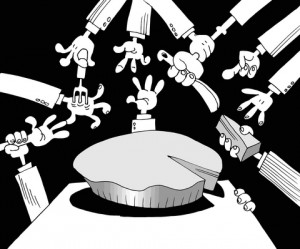 Les médias sociaux, le web 2.0 permettent aux simples citoyens de se regrouper et d’avoir accès à de l’information pour la guerre contre la corruption.
Les médias sociaux, le web 2.0 permettent aux simples citoyens de se regrouper et d’avoir accès à de l’information pour la guerre contre la corruption.
La Banque mondiale retient les formes suivantes pour déterminer ce qu’est la corruption:
- l’Argent noir en dessous de la table;
- la fraude, falsification des données;
- l’extorsion;
- le favoritisme;
- le détournement.
Selon cette derniere, mille millards de dollars US se perd chaque année en pot de vin dans le monde.
Le site www.tranparancy.org vient de publier un article sur l’utilisation des médias sociaux par les simples citoyens par une communication plus participative, la possibilité de dénoncer des abus, d’informer :
In the social web, the fight against corruption becomes relevant for all citizens. It provides anyone with an opportunity to voice their concerns and engage in the fight against corruption. This can be done by signing a petition online, by gathering evidence of corrupt activities, or by blowing the whistle anonymously. In giving voice to unfiltered observations and sharing of information, blogs can play an important role for making governments, public institutions and corporations more accountable. A powerful example is the one from J. N. Jayashree from India, who started a blog to protect her husband – a whistleblower. Through the worldwide internet these voices suddenly become public making it more difficult for leaders to ignore them. As Irene Khan, Secretary General of Amnesty International said, the best tool to fight corruption is an empowered citizen.
L’internet est un incontournable et les gouvernements se doivent de rendre l’internet accessible partout sur leur territoire. Quoique au Canada, l’internet est dispendieux, imaginez dans les pays en voie de développement. Michelle Blanc a d’ailleurs écrit un article à ce sujet:Le Canada est le tiers monde des technos usager.
Toujours selon “Transparency International” Les médias sociaux transforment la lutte à la corruption en:
1)Collaborative and crowd-based. Activists, victims and small groups working on the same issue can link up more easily, and gather in a bigger anti-corruption movement. The dream is the old metaphor of the many little fish that eat the big fish.
Crowdsourcing as a tactic can be an option for using collective power. For example when looking at datasets made available under the umbrella of transparency or interpreting data collectively, or for community-based or citizen journalism, as reflected by the NY Times and the People, Spaces, Deliberations-Blog.
2) De-centralised. De-centralised action and new forms of organisation will be developed where necessary. Global protests were initiated after elections in Iran or Moldova, as well as on 4 February 2008 under the motto “A Million Voices Against FARC” via Facebook. The Facebook Revolution in Egypt is another well-known example for de-centralised organisation.
Particularly under restrictive regimes – where civil society is challenged when organising itself – social media can be used to organise, meet virtually and work together to overcome boundaries without sharing a physical space. Google maps can be used as a great tool to track and plan actions.
3) Empowering. Social media can empower people that want to change things. It becomes bottom-up by giving voice to the people affected most. By contributing their experience, easily done via blogs, twitter, or a wiki, they can become part of the movement and give faces to the issues. Through the internet these voices become public, making it more difficult for leaders held accountable to ignore them.
Le 9 décembre est la journée internationale anti-corruption.

2fuvcmr9yj

